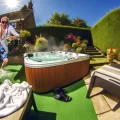Explore the dos and don’ts of drinking in a hot tub. From safety tips to the best beverages, learn how to enhance your soak without compromising your health.
Imagine a serene evening in your backyard, slipping into the warm embrace of your hot tub with a drink in hand. The concept of enjoying a beverage while soaking in the soothing waters is a popular image of relaxation and luxury.
However, it’s essential to navigate this indulgence with an understanding of safety and best practices to ensure your leisure doesn’t turn into a health hazard.
The Safety of Sipping in the Spa
Combining hot tubs and drinks, particularly alcoholic beverages, requires a careful approach. The warm water can amplify the effects of alcohol, leading to quicker intoxication, dehydration, and even the risk of drowning.
Experts recommend moderation and constant hydration with water to counteract the heat’s effects and maintain a safe, enjoyable experience.
Hydration is Key
The key to a safe hot tub experience, especially when consuming beverages, is staying hydrated. Alcohol can dehydrate the body, and the hot tub’s warmth exacerbates this effect.
Drinking plenty of water or enjoying hydrating, non-alcoholic beverages can help you stay safe and get the most out of your relaxation time.
Best Beverages for Your Bubbles
Opting for refreshing, non-alcoholic drinks can enhance your hot tub experience without the risks associated with alcohol. Consider hydrating options like fruit-infused waters, iced herbal teas, or even non-alcoholic beers and wines.
These choices keep you hydrated, allowing you to enjoy your soak for more extended periods safely. You can also like our 5 Surprising Facts: Does Drinking in a Hot Tub Get you Drunk Faster?
Alcohol and the Hot Tub: A Risky Mix?
While it’s common to associate hot tubs with a glass of wine or a cold beer, understanding the risks is crucial. The heat from the hot tub can increase your body’s reaction to alcohol, leading to potential health risks.
If you choose to drink alcohol, do so in moderation, keep track of your consumption, and always have water at hand to avoid dehydration.
Health Considerations and Consequences
Drinking in a hot tub isn’t without its health considerations. From dehydration and overheating to more severe risks like heat stroke or heart strain, it’s essential to recognize the signs of trouble.
Health professionals advise setting a limit on your soak time and alcohol intake to prevent adverse effects.
Enhancing Your Hot Tub Experience
There are plenty of ways to make your hot tub gathering or solo soak more enjoyable with drinks. Consider investing in floating drink holders or non-breakable drinkware to keep your beverages close without the risk of accidents.
Setting a relaxed ambiance with lighting and music can also complement your drink choice, creating the ultimate relaxation experience.
Best Practices for Drinking in a Hot Tub
To ensure a safe and enjoyable hot tub experience, follow these best practices:
- Avoid glass containers to prevent accidents.
- Limit your alcohol intake and prioritize hydration.
- Keep a water bottle within reach to stay hydrated.
- Monitor your time in the hot tub, taking breaks to cool down.
Understanding the Effects of Alcohol and Hot Tub Use
- Dehydration Rate Increase: Studies have shown that soaking in a hot tub can increase dehydration rates by up to 3 times compared to not being in hot water. Adding alcohol, which is a diuretic, can further exacerbate dehydration, making it crucial to balance any alcoholic beverages with plenty of water.
- Alcohol Absorption: The absorption rate of alcohol can increase in the heat, leading to a faster onset of intoxication. This can be particularly concerning in a hot tub, where the warm environment can cause blood vessels to dilate and increase the rate at which alcohol enters the bloodstream.
- Risk of Accidents: According to safety reports, alcohol is involved in approximately 70% of all adult deaths associated with water recreation. While not all these incidents occur in hot tubs, the statistic underscores the importance of caution when mixing alcohol and water activities.
- Health Benefits of Moderate Hot Tub Use: Regular, moderate use of a hot tub, without the influence of alcohol, has been linked to reduced stress and anxiety, lower blood pressure, and improved sleep patterns, according to a study published in the Journal of Physiology.
- Hot Tub Temperatures and Alcohol Effect: The optimal temperature for a hot tub is generally considered to be between 100°F to 102°F (37°C to 39°C). At these temperatures, the body’s ability to metabolize alcohol can be slowed, making it important to moderate alcohol consumption to avoid negative health effects.
- Hydration Tips: Health experts recommend drinking at least one glass of water for every alcoholic drink consumed to help maintain hydration levels. This is especially important in a hot tub, where the heat can lead to increased sweating and fluid loss.
Conclusion
Enjoying a drink in the hot tub is a hallmark of relaxation and luxury for many. By following the safety tips and best practices outlined, you can ensure that your indulgence remains a safe and enjoyable experience.
Remember, moderation and hydration are critical to a health-conscious soak.
For more insights on making the most of your hot tub experience, including care tips, health advice, and creative ideas for your next soak, visit Hot Tub Patio. Dive deeper into the world of hot tub enjoyment with our expert guides and articles.
The U.S. guidelines for drinking alcohol are quite clear. According to the 2020–2025 Dietary Guidelines for Americans, adults of legal drinking age can choose not to drink or to drink in moderation by limiting intake to 2 drinks or less in a day for men and 1 drink or less in a day for women when alcohol is consumed.
It’s important to note that drinking less is better for health than drinking more, and there are certain individuals who should not consume alcohol at all, such as those who are pregnant, under the age of 21, taking medications that interact with alcohol, managing a medical condition that can be made worse by drinking, recovering from alcohol use disorder, or unable to control the amount they drink.
For more detailed information, you can refer to the following sources:
- Rethinking Drinking provides an overview of the U.S. alcohol and drinking guidelines.
- The CDC’s Facts about moderate drinking page offers insights into the risks associated with alcohol consumption and the recommended guidelines for moderate drinking.
- Another CDC page elaborates on the health risks of drinking too much alcohol and the importance of moderation.
- The CDC’s Alcohol Use and Your Health PDF document outlines the guidelines for moderate drinking and the associated health considerations.



No Responses